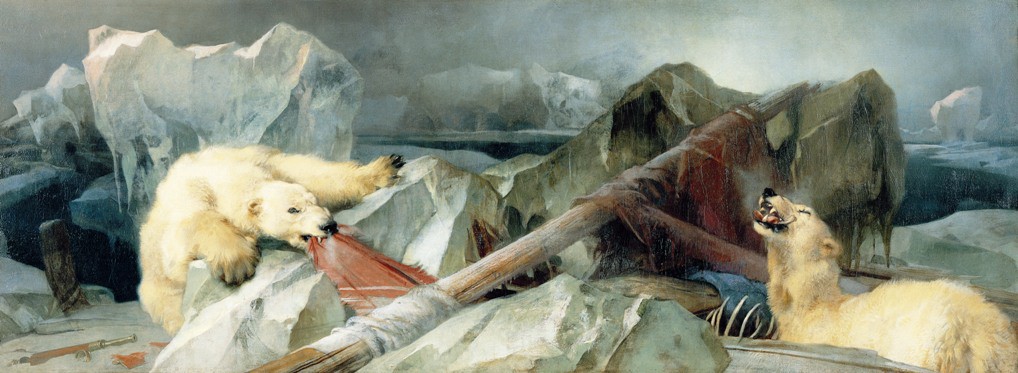A few years ago, along with a bunch of other folks, I became mildly obsessed with the AMC series The Terror, which follows two 19th century British ships attempting to navigate the Northwest Passage. Within two episodes, the ships are stuck in winter ice, and the crew assaulted by a supernatural creature. I’m not going to delve into spoiler territory, but suffice to say the ships’ 100-odd sailors are quickly whittled down by punishing elements, monstrous teeth, and jump scares:
The show is based on a 2007 novel by Dan Simmons, which itself is based on the real-life expedition of the HMS Terror and HMS Erebus in 1845. That expedition did not end well, although it’s difficult to say exactly what befell the unfortunate crew, because none of them made it back to England alive.
Leading the expedition was Sir John Franklin (born in 1786), a Royal Navy officer who enjoyed an illustrious career; in addition to being present at the epic Battle of Trafalgar, he had also served as lieutenant governor of present-day Tasmania for roughly six years. By the time of the expedition, he was 59 years old, but evidently felt capable of leading more than 130 men into the harsh conditions of the Arctic. The mission: figure out how to sail above Canada to the Pacific, past uncharted islands and tons of ice.
Hubristic? Potentially; but the British empire spent the 19th century launching a number of dangerous adventures. In any case, the expedition’s leaders felt they had the ships to match the challenge: Both the HMS Terror and HMS Erebus were considered extraordinarily advanced for their day. In addition to bows reinforced with iron (in order to resist the crush of the ice pack), each had a steam-driven propeller capable of roughly four knots. That steam also powered an internal heating system. The expedition had provisions for three years, the bulk of it in lead-lined tins, along with top-of-the-line navigation instruments.
The ships left England in May, sailing for Greenland and then Canada; they made it to Lancaster Sound, at the entrance to the Northwest Passage, by the end of July. From there, the historical record becomes spotty. Franklin made the decision to winter off Beechey Island, an inhospitable bit of rock and ice between Lancaster Sound and Wellington Channel. Later, searchers would find the graves of three crewmen on the island; the bodies, remarkably well-preserved by the harsh elements, would one day yield a vital clue as to the fate of the expedition.
It seems that Terror and Erebus wintered at Beechey through 1846. Summer arrived, and the ships managed to make it south, to King William Island, before the ice encroached again.
A Rescue Attempt, and Two Messages
During this era, any information not carried by telegraph or semaphore line could only move at the speed of a railroad or ship; it wasn’t unusual to wait years for a message from the other side of the world. As a result, panic over the expedition’s fate didn’t begin for nearly three years after the ships set sail. By 1848, the lack of word from Franklin or his crew led the British admiralty to launch a rescue expedition via land and sea. In 1850, a few rescuers arrived at Beechey Island, where they found the graves (marked ‘1846’) and little else.
A few years later, in 1854, explorer John Rae encountered some Inuit people in Pelly Bay who told him about a group of Englishmen — as many as 40, potentially — who had perished of starvation and disease near the mouth of the Back River, which is nearly due south of King William Island. As evidence of their tale, the Inuit showed Rae a collection of artifacts, including a telescope. More disturbing, they also reported that the Englishmen had fed on each other before dying.
Rae dutifully transmitted the news to the British admiralty, complete with gruesome details: “From the mutilated state of many of the bodies and the contents of the kettles [found in the survivors’ camp], it is evident that our wretched Countrymen had been driven to the last dread alternative — cannibalism — as a means of prolonging existence.”
The British public, upon receiving this report from the admiralty, predictably freaked out. Charles Dickens, in his weekly magazine Household Words, dismissed it as the “vague babble [and] wild tales of a herd of savages,” and even went so far as to suggest that the indigenous people had killed the sailors.
But in 1859, more evidence emerged that something had gone very, very wrong with Franklin’s expedition. Searchers in the northern reaches of King William Island found a rock cairn with a tin canister inside, which held a note with two messages in different hands. The first message, written in May 1847 on the prescribed lines, described everything as “all well” following the expedition’s wintering in 1846:
28 of May 1847 H.M.S.hips Erebus and Terror Wintered in the Ice in Lat. 70°5’N Long. 98°.23’W Having wintered in 1846–7 at Beechey Island in Lat 74°43’28″N Long 91°39’15″W After having ascended Wellington Channel to Lat 77° and returned by the West side of Cornwallis Island. Sir John Franklin commanding the Expedition. All well Party consisting of 2 Officers and 6 Men left the ships on Monday 24th May 1847. — Gm. Gore, Lieut., Chas. F. DesVoeux, Mate
The second missive, written later, offered a much starker update:
25th April 1848 HMShips Terror and Erebus were deserted on the 22nd April 5 leagues NNW of this having been beset since 12th Sept 1846. The officers and crews consisting of 105 souls under the command of Captain F. R. M. Crozier landed here — in Lat. 69°37’42” Long. 98°41′ Sir John Franklin died on the 11th of June 1847 and the total loss by deaths in the Expedition has been to this date 9 officers and 15 men.
— James Fitzjames Captain HMS Erebus
F. R. M. Crozier Captain & Senior Offr
And start on tomorrow 26th for Backs Fish River
No other notes were ever found.
Fragments and Myths
Over the next several years, more searchers would find artifacts — combs, cuttery, soup tins, fragments of shirts, pencil cases, fish hooks, musket balls — from the lost expedition scattered over the islands, but no remains of the sailors themselves. Meanwhile, some of the rescue attempts ran into trouble. The HMS Resolute, trapped in the ice in 1854, was abandoned by its crew, and seemingly lost until an American whaler discovered it the next year; wood from the ship was made into the Resolute desk, which currently sits in the Oval Office.
What had happened to the boats? In 2014, researchers would discover the HMS Erebus, sunk in the Queen Maud Gulf, pretty far west of King William Island; in 2016, the HMS Terror was found south of the island, in fairly good condition. It is difficult to tell why they sunk, or what led the crew to abandon them; the Inuit provided some eyewitness accountsof the ships sinking, but it’s impossible to figure out the times and places in those recollections.
And what had happened to the sailors? An autopsy conducted in the 1980s found that the Beechey Island crew had died of tuberculosis and pneumonia, possibly exacerbated by lead poisoning. The elevated lead levels may have come from poorly soldered cans, as well as ship pipes used to deliver water. (In fact, the pipes may have been a primary culprit; other British crews around the world ate from cans prepared in a similar manner, without experiencing catastrophic lead poisoning — and besides, higher lead levels were common in men and women at the time.)
Trapped in the ice for two hard winters, stricken with disease and nutritional deficiencies, the crew had weakened to the point where escape south seemed like the only option; but trekking through the wilderness came with its own hardships, including a lack of proper equipment, which forced the final descent into the unmentionable. Fragments of bone, found on King William Island in the early 1990s and connected to the expedition, had been cut in a way that indeed suggested cannibalism. (Sorry, Dickens.)
Franklin and his men had set out to conquer the Arctic, but in the end, the Arctic conquered them. Despite that tragic ending, the battle of ‘human vs. elements’ has continued to hold our imaginations ever since.

